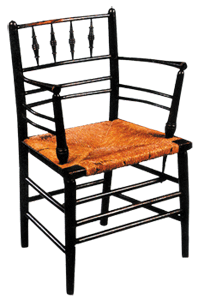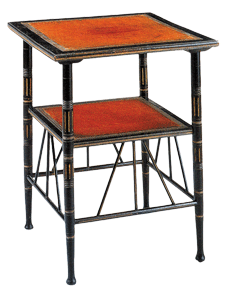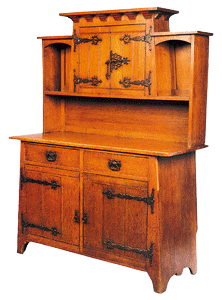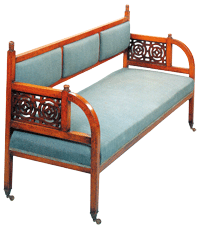- Guest Editor’s Column
- Docedge the Asian documentary forum
- Creative Impulse
- Arts and Crafts Movement : Mission Style Furniture
- Porcelain-enamel Advertising Signs
- Passions run high over the auction of Tagore's paintings
- In the News
- Controversy
- Artist Index and Statistics
- Market Insight
- Auction Reports : What happened
- Auction Reports : what's forthcoming
- Art's eye-view
- The month that was
- Mumbai Artsighting
- Art Bengaluru
- Musings from Chennai
- Deccan Odyssey
- North-East Opsis
- The Wreckage
- Inscription in Bronze
- Black and White
- Nature God
- Indian Highway
- Structures Within an Intervention
- Hard Talk
- Different hues of Aakriti
- Christie’s : Important Watches
ART news & views
Arts and Crafts Movement : Mission Style Furniture
Volume: 2 Issue No: 5 Month: 6 Year: 2010
The Arts and Crafts movement evolved and developed in England, in the second half of the 19th century. Subsequently this style was taken up by the American designers, with somewhat different results. In the United States, the Arts and Crafts style was also known as Mission style. This movement, which challenged the tastes of the Victorian era, was inspired by the social reform concerns of thinkers such as Walter Crane and John Ruskin, together with the ideals of reformer and designer, William Morris.
 |
The Arts and Craft Movement became even more diverse in the 1870s, when the revival of an interest in the Arts and Crafts in Britain was exported and grafted onto indigenous traditions abroad. In the United States, the revival of craft traditions had a resonant appeal for a nation with strong political affinity with individualism and for things handmade and homespun. It is interesting to note that decades before the exponents of Art and Craft Movement began to criticize the influence of industrialization; Shaker communities in the United States were producing simple furniture and buildings that echoed many of the creative and social ideals of the Arts and Craft Movement.
 |
The revival of arts and Crafts in the second half of the century embodied a rich and varied tradition of political, religious and aesthetic ideas that found form in a variety of media, yet there were some principles and articles of faith common to the Arts and Crafts Movement in general. The belief that a well designed environment- fashioned with beautiful and well-crafted buildings, furniture, tapestries and ceramics-would serve to improve the fabric of society for both producers and consumers is a theme common to the Arts and Crafts Movement in both the 19th and 20th centuries. The idea was expressed by William Morris in the middle of the 19th century.
 |
In Arts and Craft Movement the notions of good design were linked to their notions of a good society. This was a vision of a society in which the worker was not brutalized by the working conditions found in factories, but rather could take pride in his craftsmanship and skill. The rise of a consumer class coincided with the rise of manufactured consumer goods. In this period, manufactured goods were often poor in design and quality. Ruskin, Morris, and others proposed that it would be better for all if individual craftsmanship could be revived-- the worker could then produce beautiful objects that exhibited the result of fine craftsmanship, as opposed to the shoddy products of mass production. Thus the goal was to create design that was... “ for the people and by the people, and a source of pleasure to the maker and the user." Workers could produce beautiful objects that would enhance the lives of ordinary people, and at the same time provide decent employment for the craftsman.
 |
However, in time the English Arts and Crafts movement came to stress craftsmanship at the expense of mass market pricing. The result was exquisitely made and decorated pieces that could only be afforded by the very wealthy. Thus the idea of art for the people was lost, and only relatively few craftsman could be employed making these fine pieces. This evolved English Arts and Crafts style came to be known as "Aesthetic Style." It shared some characteristics with the French/Belgian Art Nouveau movement.
 |
In the United States, the Arts and Crafts ideal of design for the masses was more fully realized, though at the expense of the fine individualized craftsmanship typical of the English style. In New York, Gustav Stickley was trying to serve a burgeoning market of middle class consumers who wanted affordable, decent looking furniture. By using factory methods to produce basic components, and utilizing craftsmen to finish and assemble, he was able to produce sturdy, serviceable furniture which was sold in vast quantities, and still survives. The rectilinear, simpler American Arts and Crafts forms came to dominate American architecture, interiors, and furnishings in the late nineteenth and early twentieth century. Today Stickley's furniture is prized by collectors, and the Stickley Company still exists, producing reproductions of the original Stickley designs. The term “Mission style” was also used to describe Arts and Crafts Furniture and design in the United States. The use of this term reflects the influence of traditional furnishings and interiors from the American Southwest, which had many features in common with the earlier British Arts and Crafts forms.
 |
Arts & Crafts Movement ideas were given an even wider audience during the 1882 American tour of Oscar Wilde. He championed Morris, the Pre-Raphaelites and the design and art-manufacturing philosophy in lectures presented in over 120 North American towns and cities. By the mid-1880's, English designs and locally made Arts & Crafts products were specified by trendsetting American architects and selected by affluent homeowners for the most stylish and fashionable American townhouses, suburban cottages and country villas. It was the children who grew up in these artistic homes of the 1880s who became patrons of Gustav Stickley, subscribed to the Craftsman Magazine, and built bungalows for their first homes.
 |
Medieval Guilds provided a model for the ideal craft production system. Aesthetic ideas were also borrowed from Medieval European and Islamic sources. Japanese ideas were also incorporated early Arts and Crafts forms. The forms of Arts and Crafts style were typically rectilinear and angular, with stylized decorative motifs reminiscent of medieval and Islamic design. In addition to William Morris, Charles Voysey was another important innovator in this style. One designer of this period, Owen Jones, published a book entitled The Grammar of Ornament, which was a sourcebook of historic decorative design elements, largely taken from medieval and Islamic sources. This work in turn inspired the use of such historic sources by other designers.
 |
The Arts and Crafts Movement started as a search for authentic design and decoration and a reaction against the styles that had developed out of machine-production. The arts & crafts furniture movement produced furniture that is distinctive in its design elements, and is not easily confused with other furniture styles. It exudes a oneness with nature and an air of elegant simplicity. Arts and Crafts objects were simple in form, without superfluous decoration, often showing the way they were put together. They followed the idea of "truth to material", preserving and emphasizing the qualities of the materials used. They often had patterns inspired by British flora and fauna and drew on the vernacular, or domestic, traditions of the British countryside. Several designer-makers set up workshops in rural areas and revived old techniques. They were influenced by the Gothic Revival (18301880) and were interested in all things medieval, using bold forms and strong colors based on medieval designs. They believed in the moral purpose of art. Truth to material, structure and function had also been advocated by A.W.N. Pugin (18121852), a leading exponent of the Gothic Revival. According to Gustav Stickley Arts and Crafts furniture style is “A severely plain and rectilinear style which was visually enriched only be expressed structural features and the warm tones of the wood”.
Amitabh Bachhawat